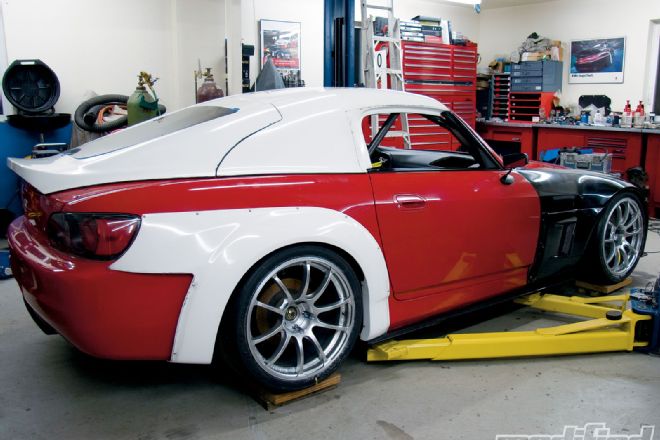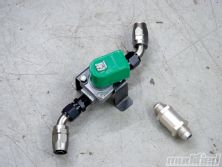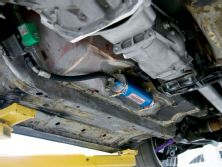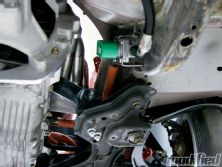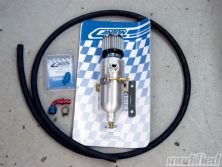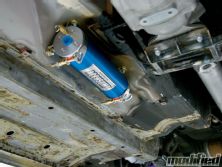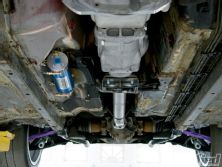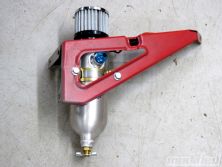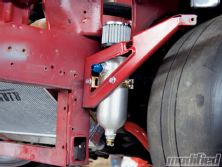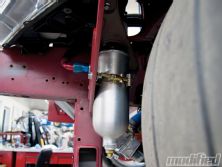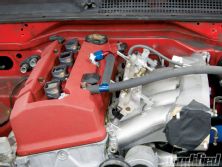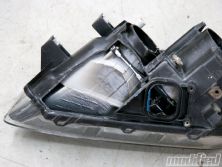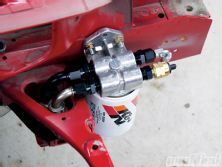Project S2K
Oil starvation is a serious issue and has claimed the life of many high-performance engines. While most production oiling systems are perfectly adequate for around-town use on street tires, oil-supply issues often arise on a racetrack with sticky DOT competition tires or slicks. This is because as lateral acceleration or g-forces increase, the unconstrained engine oil moves to the edges of the oil pan and away from the pickup. It only takes a fraction of a second with a dry oil pickup to cause bearing damage and engine failure.
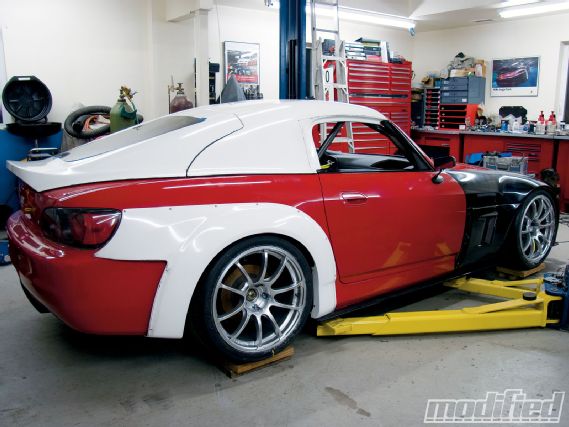 |
Honda S2000 Tuning - Accusump And Vented Catch Can Install
|
Honda S2000 Tuning - Accusump And Vented Catch Can Install
There are several methods to prevent this all-too-common form of engine death. The most effective method for purpose-built race cars is called a dry sump system. A dry sump setup uses a multi-stage external oil pump to pull vacuum on a low-profile oil pan and then feed pressurized oil from an external oil tank back to the engine. While this is the most effective solution, it's also the most complicated and costly at $11,800 for the complete Toda kit.
The S2000 uses what's known as a wet sump system, which is standard on all but the most high-performance and exotic production cars. With a wet sump, the engine oil is stored in the oil pan and a conventional pickup supplies fluid to the oil pump. Wet sump systems can be made to work in high lateral g-force situations with the use of a baffled oil pan and an Accusump. A properly designed baffled pan uses trap doors and shelves to restrict oil flow away from the pickup, ensuring a constant supply of oil to the pump and bearings. However, in longer corners with sustained high lateral g-forces, the oil can still migrate away from the pickup. This is where an Accusump can save your engine.
An Accusump is an aluminum cylinder with a piston installed. On one side of the piston, there's compressed air; on the other side, there's engine oil. When the engine is running correctly, oil pressure displaces the Accusump's piston and fills the cylinder with engine oil. Should the engine encounter a moment of low oil pressure - for example, during a high-speed corner that starts to force oil in the pan away from the pickup - the piston will expel the oil and in the process provide the engine with the necessary pressurized oil to avoid catastrophe. Once the low-pressure moment has passed (e.g. you're on a straightaway and the oil pickup has plenty of supply), the Accusump will refill with oil so that it's ready to spring into action the next time a sudden drop in oil pressure occurs.
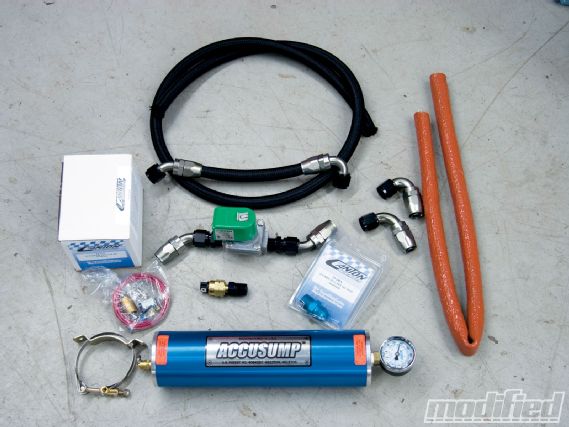 |
Adding an Accusump system is an excellent way to ensure your engine maintains oil pressure during high-cornering loads.
|
Adding an Accusump system is an excellent way to ensure your engine maintains oil pressure during high-cornering loads.
With an Accusump there are several configurations that can be used. You can order the cylinder in 1-, 2- or 3-quart capacities with either manual or electric valves. The manual valve simply requires the user to open the valve before starting the engine and to shut the valve before turning the engine off (preferably at maximum oil pressure to fill the cylinder). This process effectively "pre-oils" the engine by providing a pressurized charge of oil prior to cranking, which helps to eliminate bearing wear at cold start-up. The electric valve allows for a more remote mounting and uses a toggle switch to actuate it. However, the solenoid actuated electric valve is slightly more restrictive than the manual ball valve, and therefore has a lower flow rate when a low-oil-pressure situation arises.
There's actually one other way to configure an Accusump that provides the best of both worlds: high flow and remote mounting. By using Accusump's EPC system, the same solenoid actuated valve is triggered by an oil pressure sending unit. When oil pressure falls below a selected point (55 psi for our application), the valve opens. When oil pressure is restored (above 60 psi), the valve closes. However, the valve will always flow toward the Accusump even when closed, so anytime the engine is operating above 55 psi of oil pressure, the Accusump is being charged. The EPC system achieves higher flow because the cylinder is fully charged with the air chamber at max pressure when called upon.
One thing to be aware of is the fact that oil pressure at idle - with the engine up to temperature - will be relatively low (usually around 20 psi), and as a result, the Accusump system will partially discharge at low engine rpm. Therefore it's important to make sure the Accusump capacity you chose won't bring the oil level above the crankshaft, which can cause aeration of the engine oil (though most engines can run 1-liter overfilled without issue). Also, be sure to close the Accusump's valve with the cylinder fully charged (cool-down lap is ideal) to ensure accurate oil measurement on the dipstick.
Installation of the Accusump is a straightforward affair with the Canton Racing mounting brackets. Our downpipe will exit the passenger fender, and consequently, the location for the OEM catalytic converter worked out to be the perfect mounting location for a 1-quart Accusump. The canister is tucked above the framerails and will be guarded by the flat bottom coming in a future article. By placing the cylinder outside of the cockpit, there's no risk of any oil line failure and possible in-car fire hazard. Though the cylinder-mounted gauge is no longer visible, we'll be replacing it with a sending unit to monitor cylinder charge pressure remotely from the MoTeC ADL, enabling us to see exactly when the Accusump is opening and ensuring no air leaks are present.
While it's possible to attach the electric valve and oil-pressure sending unit directly to the Accusump, we opted to remote-mount ours. A custom bracket made for easy mounting of the electric valve to the framerail and a 0.375-inch NPT to 0.5-inch NPT adapter allowed the sending unit to be mounted in the unused port of our remote filter mount. By keeping the sending unit as close to the engine as possible, the response time is reduced.
We finished off the installation with BAT black fittings and Startlite hoses, including a -10 T fitting installed at the inlet of the block adapter. We also installed an inline check valve at the exit of the filter housing to ensure oil is fed to the block and not the oil pan when pre-oiling.
With the increased "blow by" (gases passing the piston rings) and crankcase pressure associated with forced induction (in addition to S2000s being notorious for spewing oil out the valve cover in right-hand corners), we opted to install Canton Racing's vented catch can. This aluminum catch can uses an internal baffle to help separate air from oil and vents to atmosphere through a cotton gauze filter element.
While this isn't emissions-legal, it will ensure crankcase pressures are kept at a minimum, helping with seal life and easing the flow of turbo return oil for our track-only S2K. Our mounting location just aft of the driver side headlight will allow for quick and easy emptying of the canister between sessions and doesn't occupy space under the hood. While it's possible to maintain the PCV or use an upgraded check valve, we've opted to run both valve cover outlets T'd directly to the catch can. This will help to ensure minimum crankcase pressure and maximum performance.

